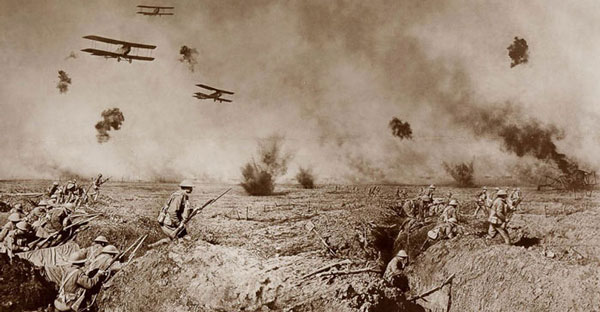The world leaders of that time called this the War to End All Wars.
Photographer James Francis Hurley joined the Australian Imperial Force on the Western Front as an honorary captain in 1917.
Frank Hurley had been no stranger to documenting under risky conditions through his camera. A year earlier, he returned to civilization after 2 years stranded in Antarctica with Ernest Shackleton and his crew, documenting a desperate struggle for survival producing a stunning set of images.
In his latest assignment at the front lines south and east of the ruined West Flanders city of Ypres, he once again risked his life and limb in an effort to photograph the conflict.
This incredible collection of photos from the State Library of New South Wales is accompanied by excerpts from Hurley’s diary. He describes his experiences in detail, including the horrors he witnesses, the pity he feels for the German soldiers, his disgust with the war, and his frustration with superiors over his photographic works to better represent the war.
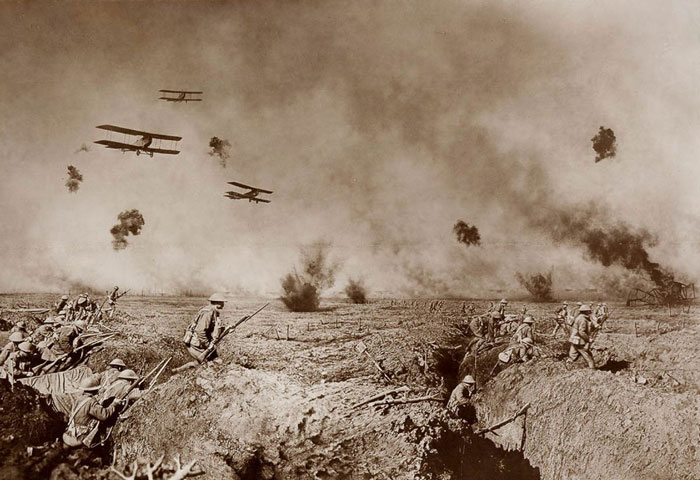
IMAGE: FRANK HURLEY/STATE LIBRARY OF NEW SOUTH WALES
“Limbers carrying up ammunition at sunset.”
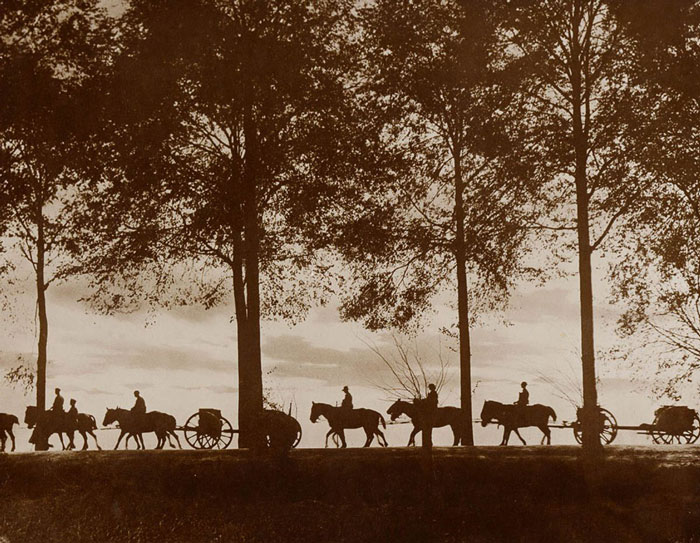
IMAGE: FRANK HURLEY/STATE LIBRARY OF NEW SOUTH WALES
“Aug. 21, 1917
As we wended our way towards Hazebrouck, the sky gradually grew brighter with the flickering quiver of hundreds of guns in action. It was the most awesome sight I have ever seen.
“Infantry marching ahead in single file to the front line.”
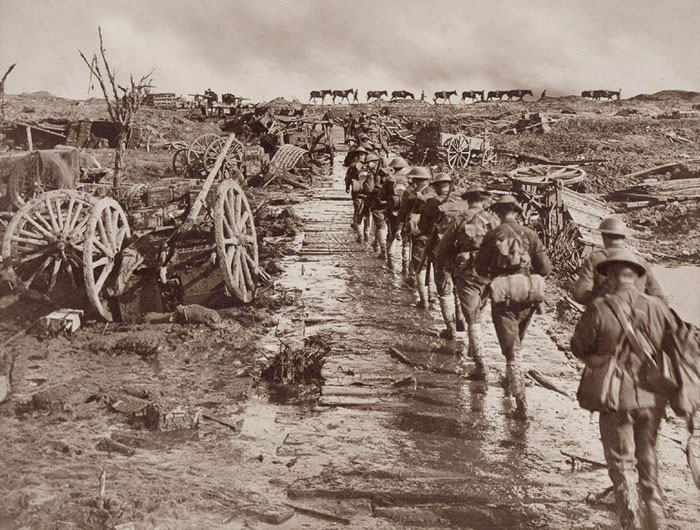
IMAGE: FRANK HURLEY/STATE LIBRARY OF NEW SOUTH WALES
“The shell shattered areas of Chateau Wood.”
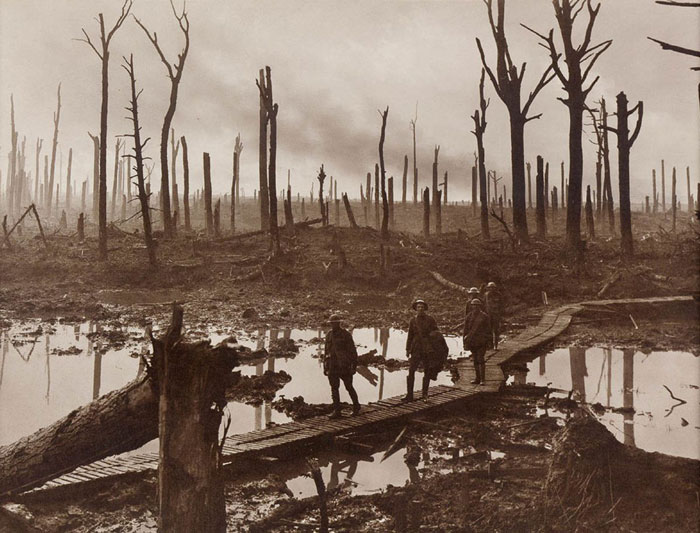
IMAGE: FRANK HURLEY/STATE LIBRARY OF NEW SOUTH WALES
“In an elephant iron dugout on Hill 60.”
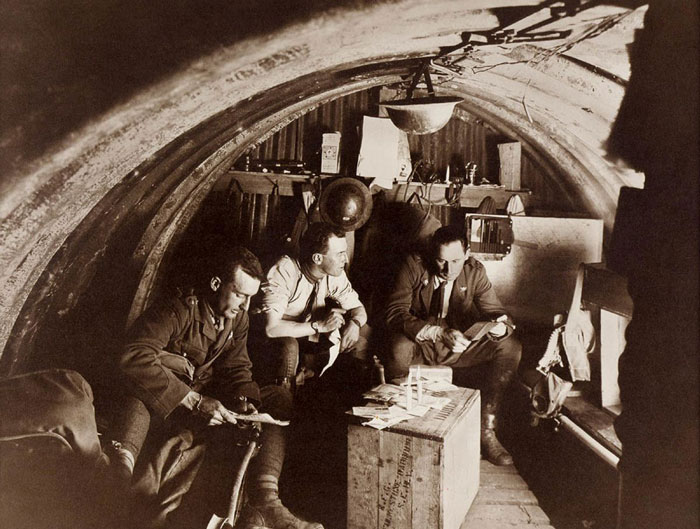
IMAGE: FRANK HURLEY/STATE LIBRARY OF NEW SOUTH WALES
“Aug. 23, 1917
The headquarters [was] situated in a series of dugouts linked together by a series of underground tunnels not unlike catacombs. Soakage trickled in through the roof or oozed through the walls, and the blackness seemed to be made blacker still by a few spluttering candles. These candles gave a convulsive jump as the reverberating shock of a near heavy gun was fired.
“Registering up a battery of Australian ‘Heavies.'”
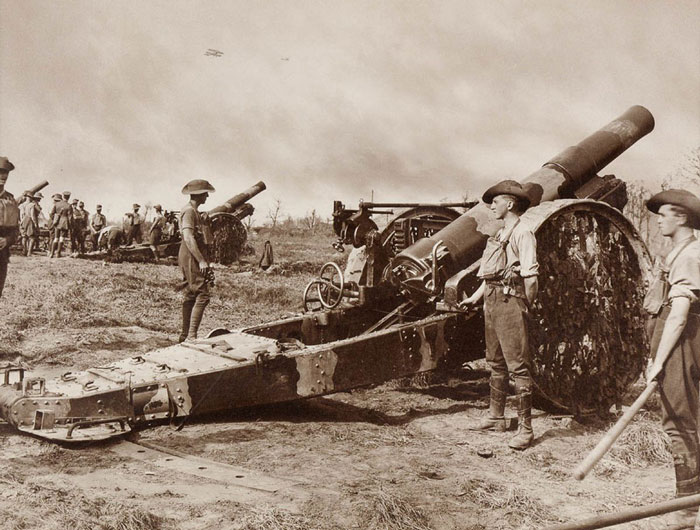
IMAGE: FRANK HURLEY/STATE LIBRARY OF NEW SOUTH WALES
“Unloading 15 inch Howitzer shells.”
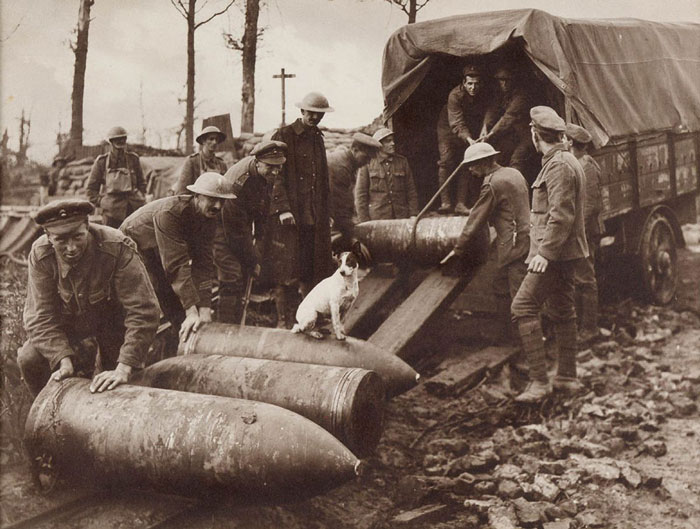
IMAGE: FRANK HURLEY/STATE LIBRARY OF NEW SOUTH WALES
“An observation balloon over the ruins of Ypres.”
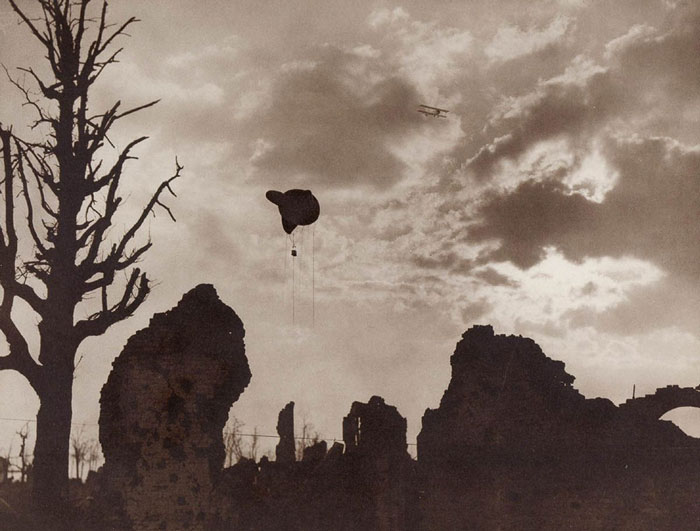
IMAGE: FRANK HURLEY/STATE LIBRARY OF NEW SOUTH WALES
“Sept. 21, 1917
It was wondrously quiet, only an occasional shell was fired — the aftermath of the storm, and it sounded for all the world like the occasional boom of a roller on a peaceful beach, with the swish of the water corresponding to the scream of the shell.
“Surrounded by invisible death.”
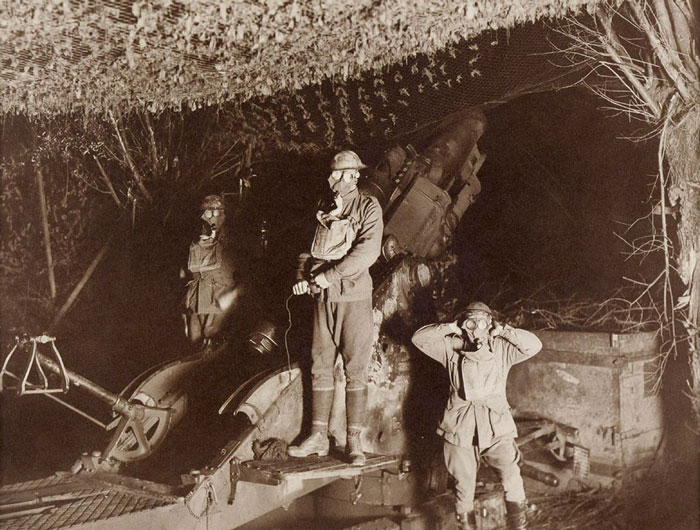
IMAGE: FRANK HURLEY/STATE LIBRARY OF NEW SOUTH WALES
“The Battle-Scarred Barracks, Ypres.”
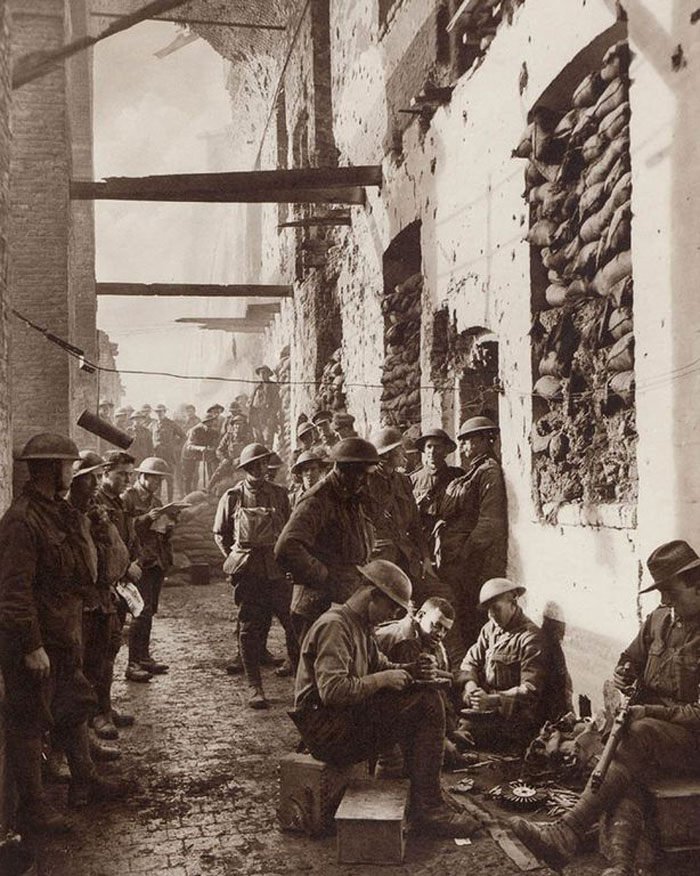
IMAGE: FRANK HURLEY/STATE LIBRARY OF NEW SOUTH WALES
“The Front Line.”
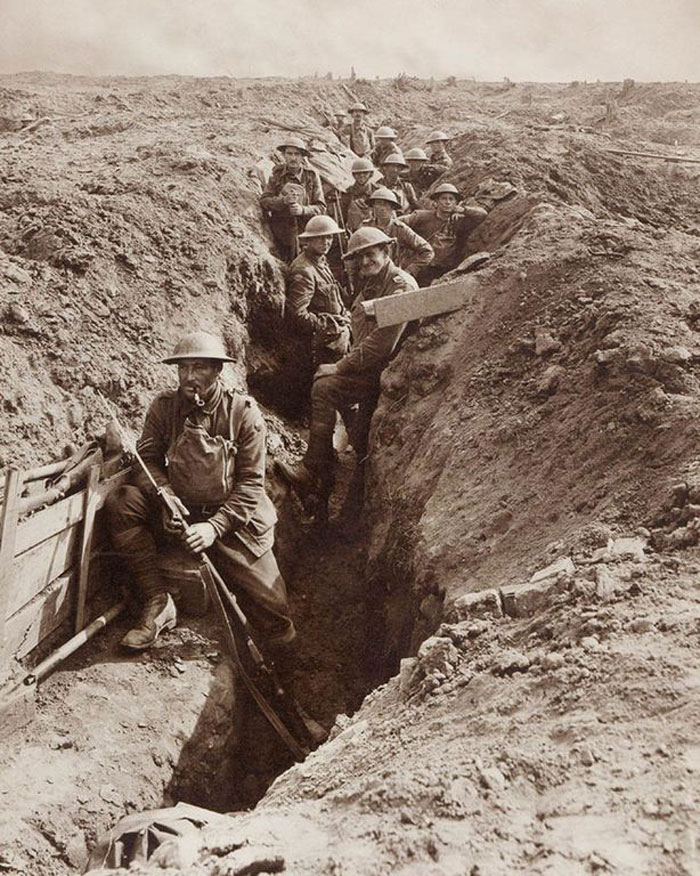
IMAGE: FRANK HURLEY/STATE LIBRARY OF NEW SOUTH WALES
“‘Fix Bayonet.’ Australian Infantry preparing to resist a counter attack.”
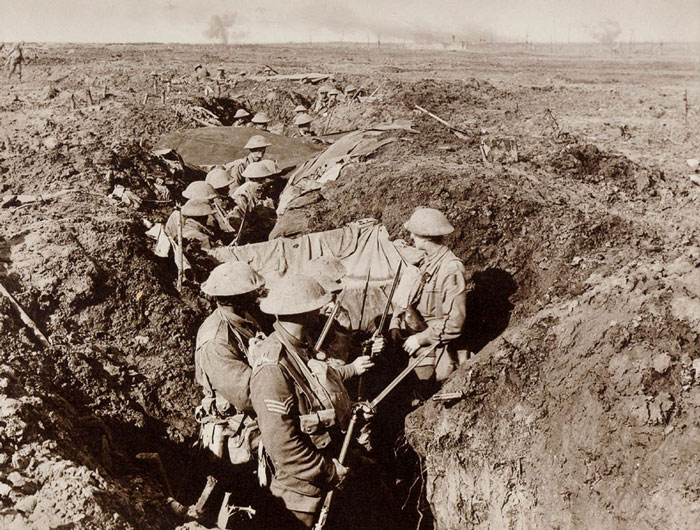
IMAGE: FRANK HURLEY/STATE LIBRARY OF NEW SOUTH WALES
“During a gas attack. Funk holes in the trenches.”
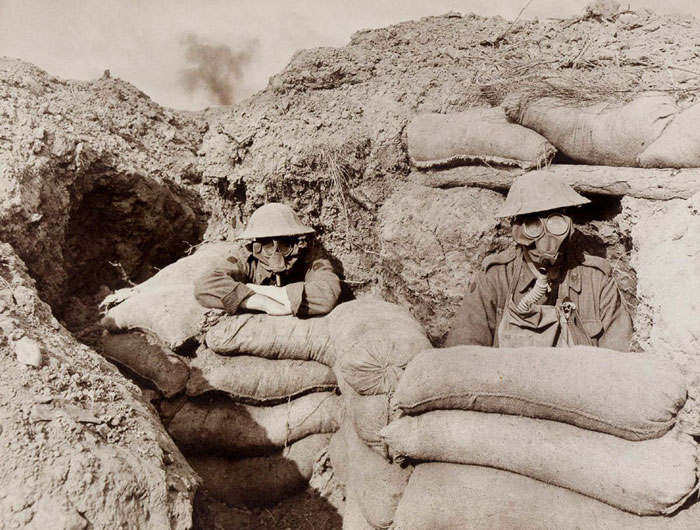
IMAGE: FRANK HURLEY/STATE LIBRARY OF NEW SOUTH WALES
“Sept. 17, 1917
The tunnelers are excavating a series of underground dugouts, which will be occupied by the headquarters of our infantry. It is a wretched job, as they are working 25 feet below the surface level and most of the time knee deep in mud.
From the roof trickles water and mud, which they jocularly term “Hero Juice” on account of it percolating through tiers and tiers of buried corpses.
“A Hun Pill-box amid surroundings characteristic of the Ypres salient.”
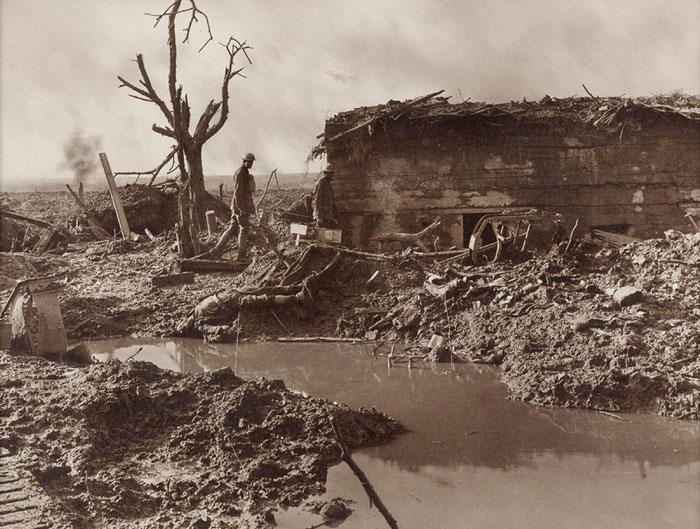
IMAGE: FRANK HURLEY/STATE LIBRARY OF NEW SOUTH WALES
“Aug. 23, 1917
Hill 60 long delayed our infantry advance, owing to its commanding position and the almost impregnable concrete emplacements and shelters constructed by the Boche. We eventually won it by tunneling underground, and then exploding three enormous mines, which practically blew the whole hill away and killed all the enemy on it. It’s the most awful and appalling sight I have ever seen.
The exaggerated machinations of hell are here typified. Everywhere the ground is littered with bits of guns, bayonets, shells and men. Way down in one of these mine craters was an awful sight. There lay three hideous, almost skeleton decomposed fragments of corpses of German gunners. Oh the frightfulness of it all. To think that these fragments were once sweethearts, maybe, husbands or loved sons, and this was the end.
“Death the Reaper.” (Multiple negative composite)
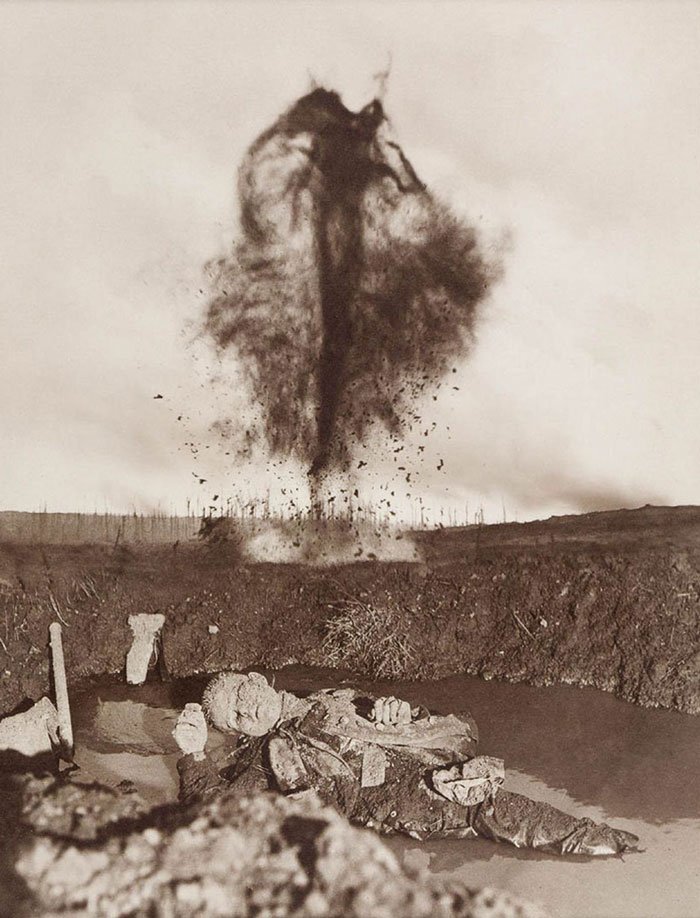
IMAGE: FRANK HURLEY/STATE LIBRARY OF NEW SOUTH WALES
“Laying a duckboard track.”
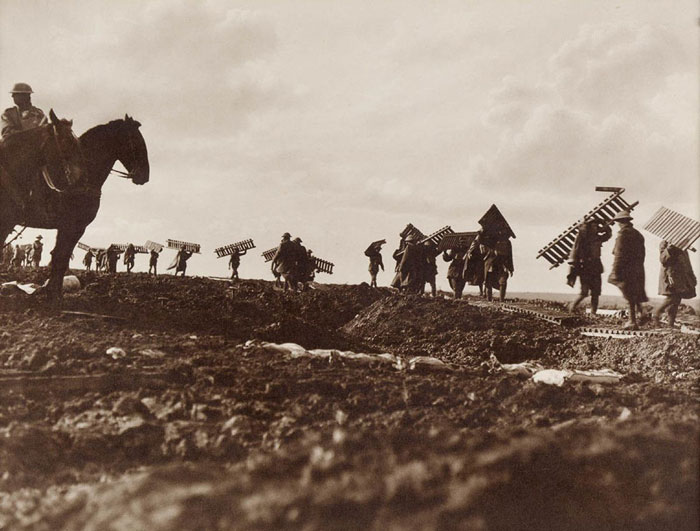
IMAGE: FRANK HURLEY/STATE LIBRARY OF NEW SOUTH WALES
“Oct. 11, 1917
One dares not venture off the duckboard or he will surely become bogged, or sink in the quicksand-like slime of rain-filled shell craters. Add to this frightful walking a harassing shellfire and soaking to the skin, and you curse the day that you were induced to put foot on this polluted damned ground.
“‘Just as it was.'”
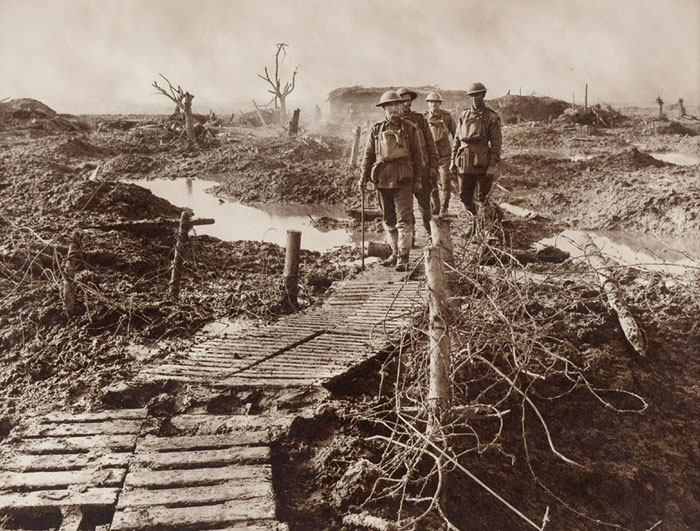
IMAGE: FRANK HURLEY/STATE LIBRARY OF NEW SOUTH WALES
“Shrapnel bursting amongst reconnoitering planes.”
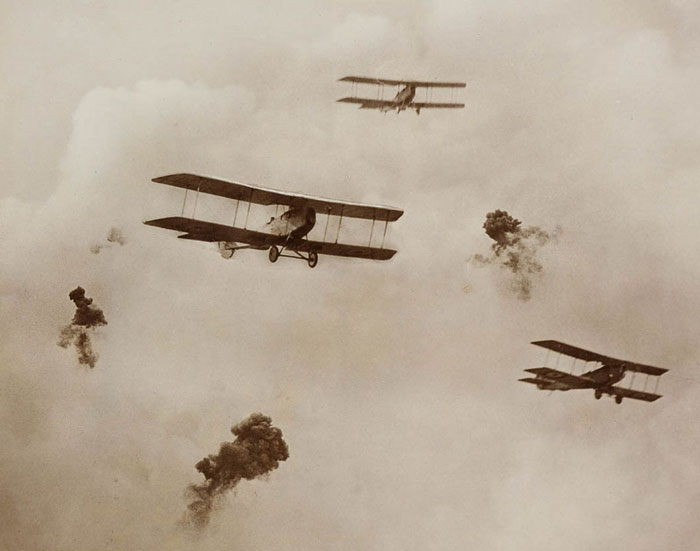
IMAGE: FRANK HURLEY/STATE LIBRARY OF NEW SOUTH WALES
“Sept. 2, 1917
Aeroplanes are far more numerous here than birds. They fly the skies at all times. In gale, rain, day and night the buzz of the engines can be heard like the buzzing of innumerable bee hives; above this buzzing one hears the occasional, crackle, crackle, crackle, of their Lewis gun, and looking up is spellbound, watching a duel between a Boche & British plane.
“Sniping enemy planes with a Lewis gun.”
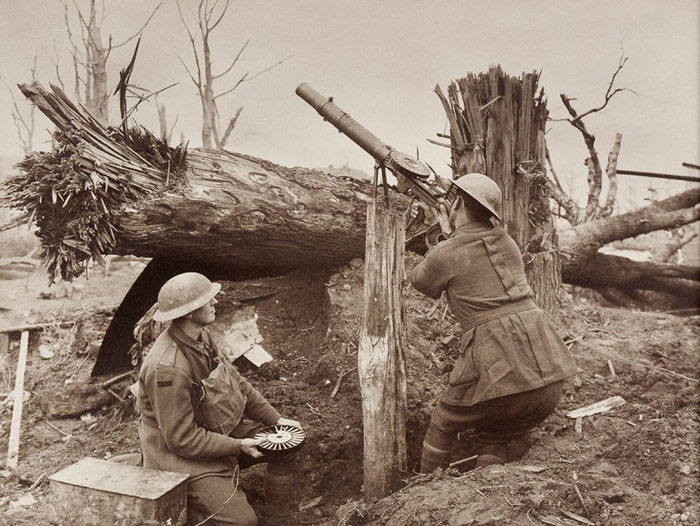
IMAGE: FRANK HURLEY/STATE LIBRARY OF NEW SOUTH WALES
“Evening by the Cloth Hall, Ypres.”
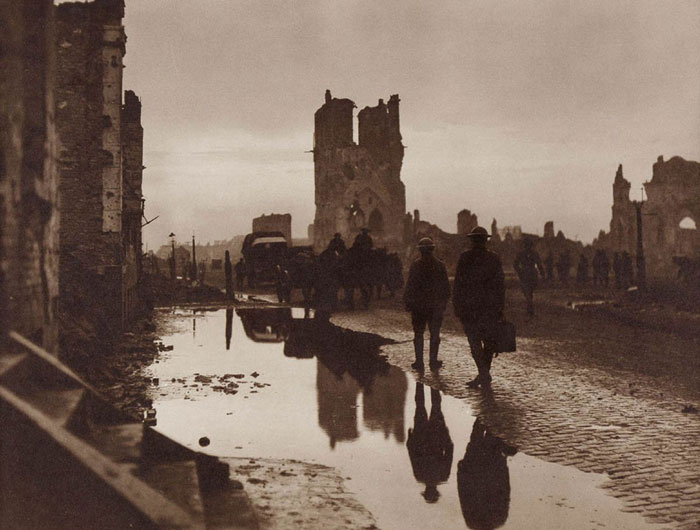
IMAGE: FRANK HURLEY/STATE LIBRARY OF NEW SOUTH WALES
“Sept. 3, 1917
To drive the Boche from Ypres, it was necessary to practically raze the town; and now that we hold it we are shelled in return, but shelling now makes little difference, for the fine buildings and churches are scarce left stone on stone.
Roaming amongst the domestic ruins made me sad. Here and there were fragments of toys: what a source of happiness they once were.
The strafed trees were coming back to life and budding, and there beside a great shell crater blossomed a single rose. How out of place it seemed amidst all this ravage. I took compassion on it and plucked it — The last rose of Ypres.
“Infantry marching through Ypres.”
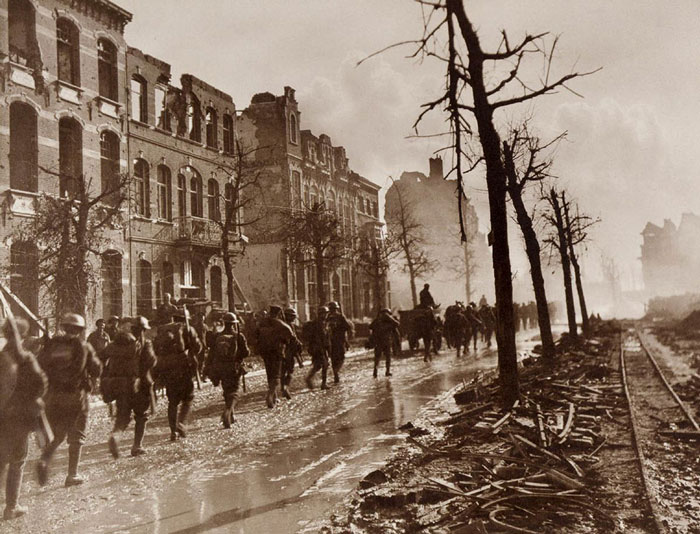
IMAGE: FRANK HURLEY/STATE LIBRARY OF NEW SOUTH WALES
“A refuge in the cellars of Ypres.”
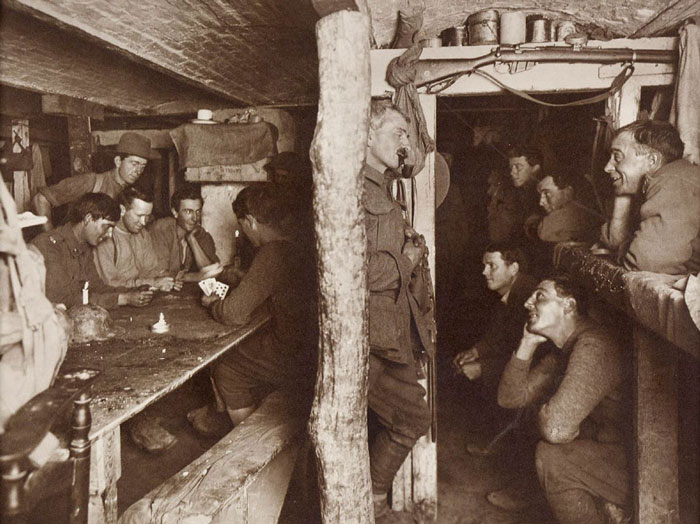
IMAGE: FRANK HURLEY/STATE LIBRARY OF NEW SOUTH WALES
“Evening in the ruined city of Ypres.”
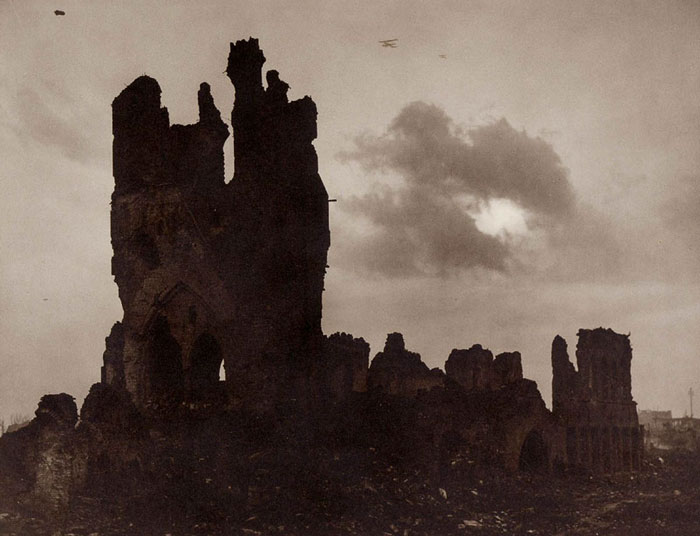
IMAGE: FRANK HURLEY/STATE LIBRARY OF NEW SOUTH WALES
“The ruined Cathedral, Ypres, viewed from the Cloth Hall.”
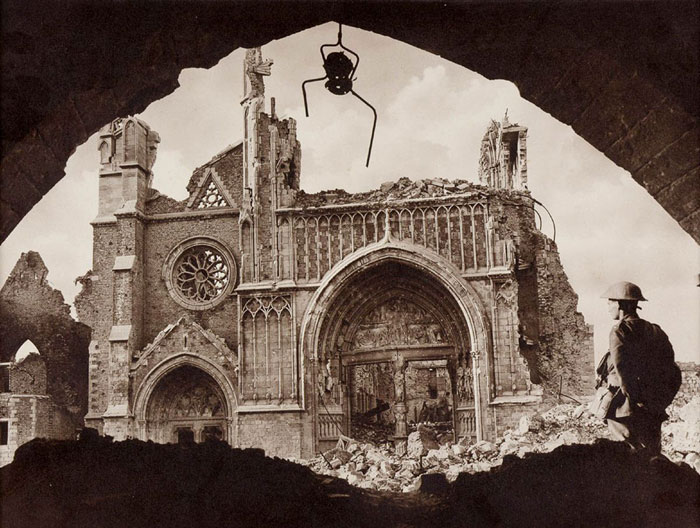
IMAGE: FRANK HURLEY/STATE LIBRARY OF NEW SOUTH WALES
“Sept. 4, 1917
I’m afraid that I’m becoming callous to many of the extraordinary sights and sounds that take place around me, and things which astounded me when I landed, now seem quite commonplace.
It is a weird, awful and terrible sight; yet somehow wildly beautiful. For my part, Ypres as it now is, has a curious fascination and aesthetically is far more interesting than the Ypres that was.
“The ruins of the Cloth Hall through a cloister window.”
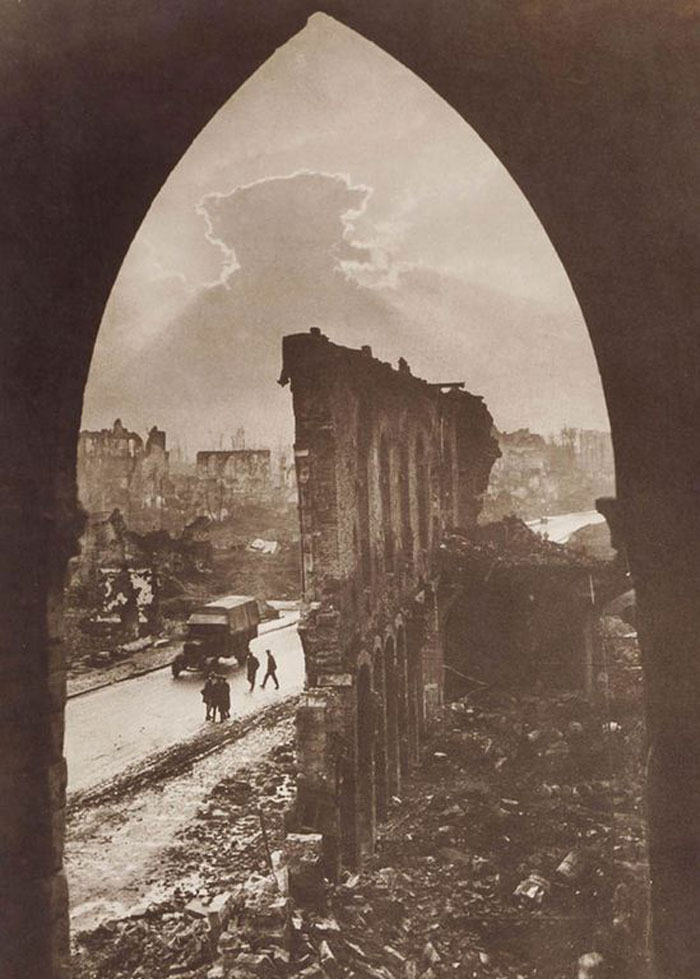
IMAGE: FRANK HURLEY/STATE LIBRARY OF NEW SOUTH WALES
“Looking out of a ruined cathedral window on to the graves of the fallen.”
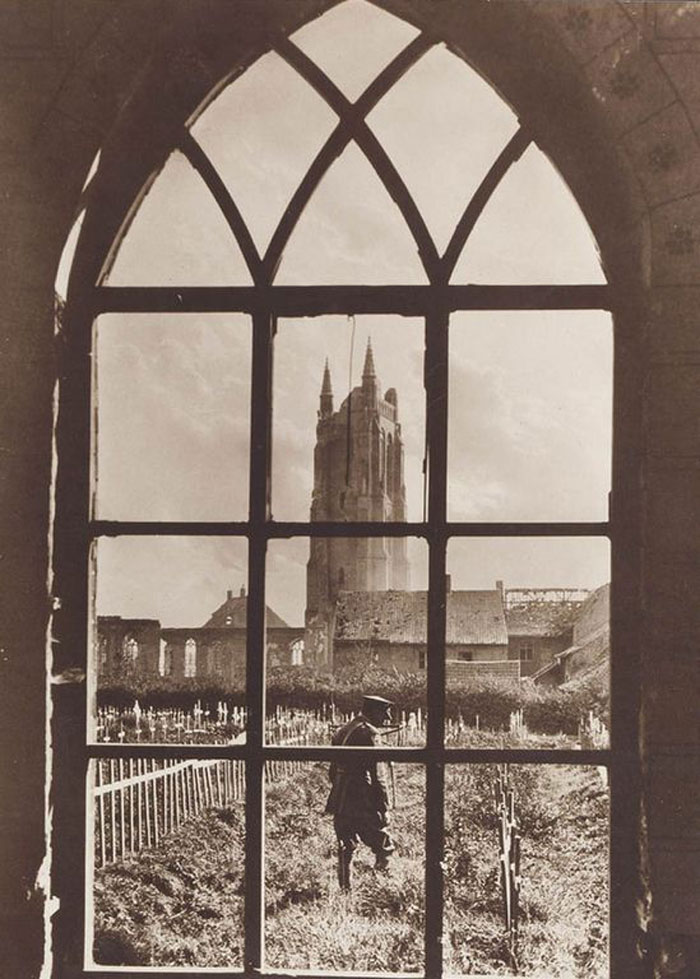
IMAGE: FRANK HURLEY/STATE LIBRARY OF NEW SOUTH WALES
“Motor transport passing through the ruined village of Vlamertinghe.”
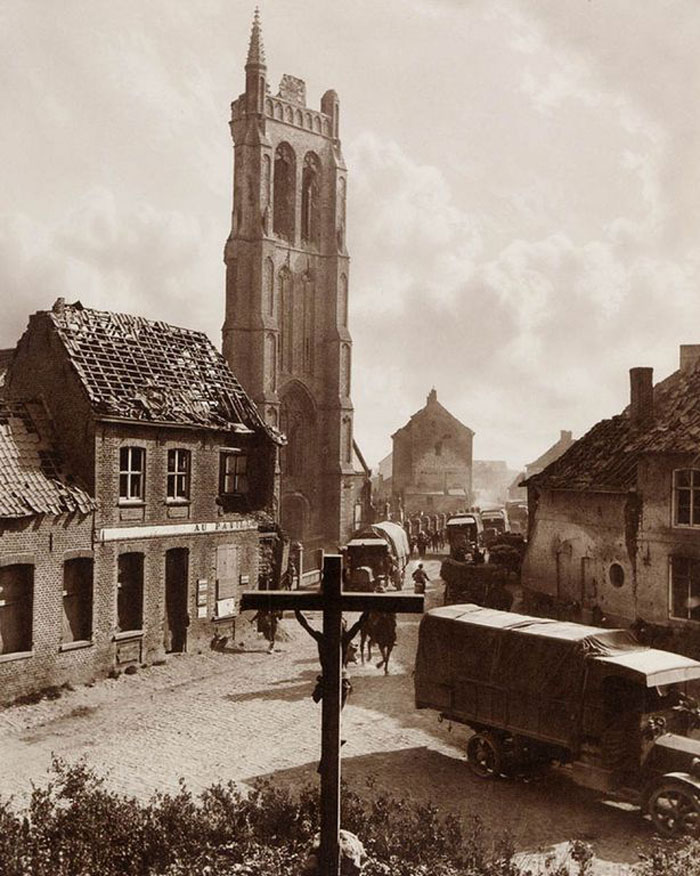
IMAGE: FRANK HURLEY/STATE LIBRARY OF NEW SOUTH WALES
“The famous leaning Madonna and Child at Albert.”
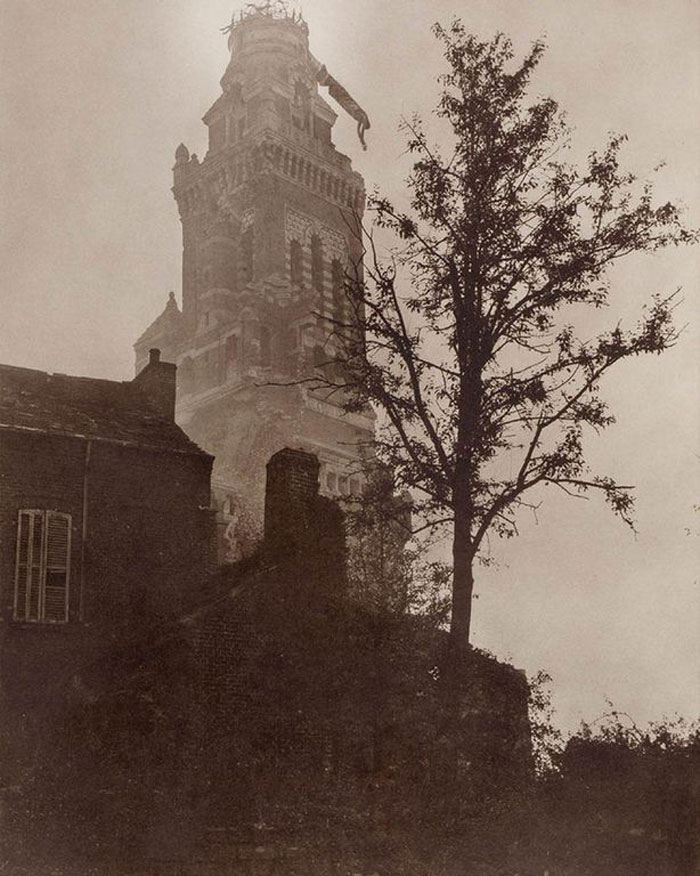
IMAGE: FRANK HURLEY/STATE LIBRARY OF NEW SOUTH WALES
“‘And Alone I Did It.'”
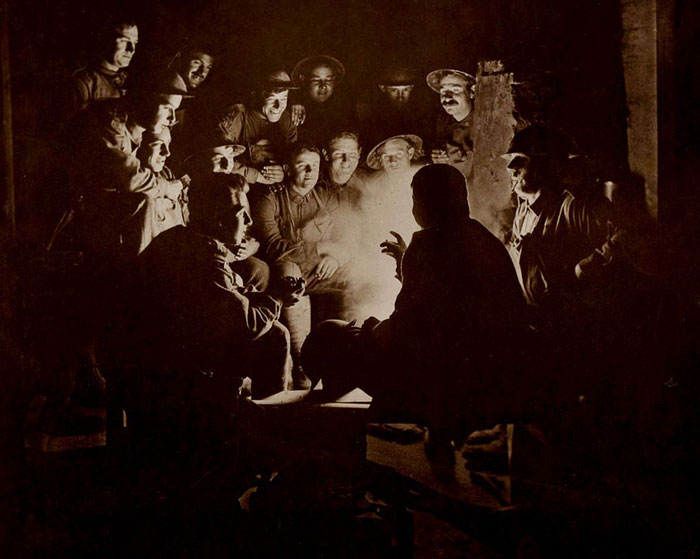
IMAGE: FRANK HURLEY/STATE LIBRARY OF NEW SOUTH WALES
“The Battle of the Menin Road in which the Australians took a prominent part.”
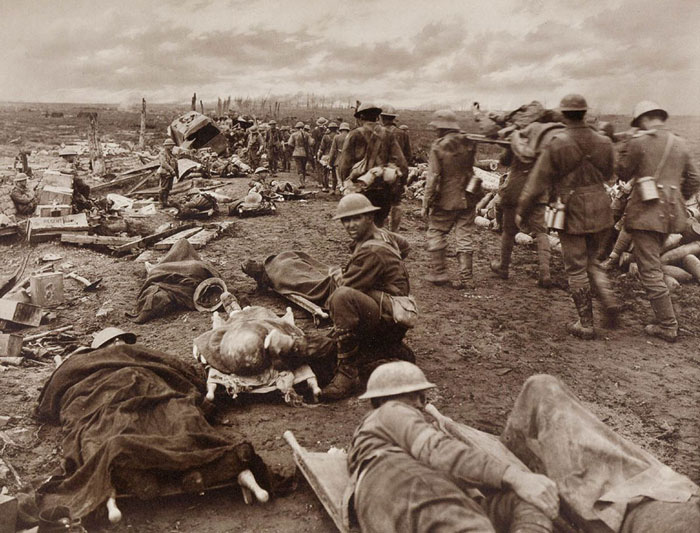
IMAGE: FRANK HURLEY/STATE LIBRARY OF NEW SOUTH WALES
“Sept. 20, 1917
It has been a glorious & frightful day. The battle is over and we have achieved our objectives.
Those that came in and were not over seriously wounded, expressed their pleasure of having escaped the horror of another battle, and it is patent that all thoroughly loathe this frightful prolongation of massacre.
“Attending to wounded in the advanced dressing station on Hill 60.”
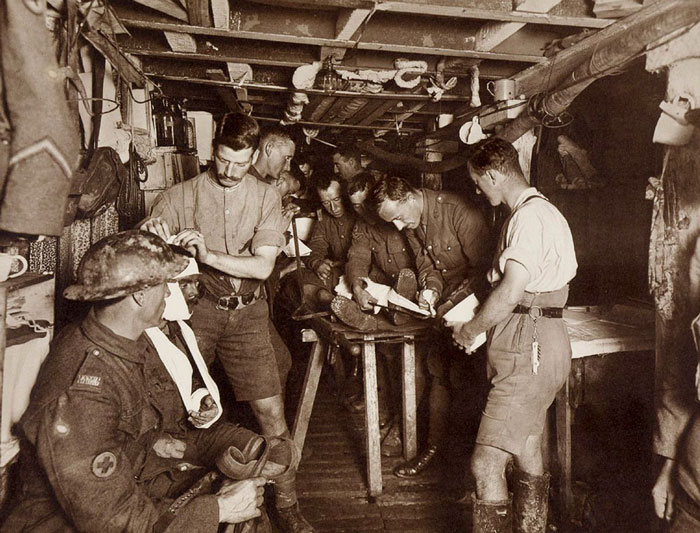
IMAGE: FRANK HURLEY/STATE LIBRARY OF NEW SOUTH WALES
“Scene in an advanced dressing station during a battle.”
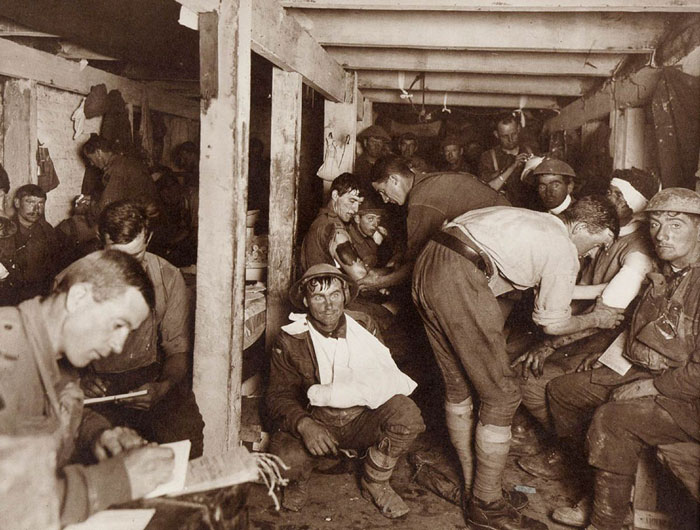
IMAGE: FRANK HURLEY/STATE LIBRARY OF NEW SOUTH WALES
“A stretcher case.”
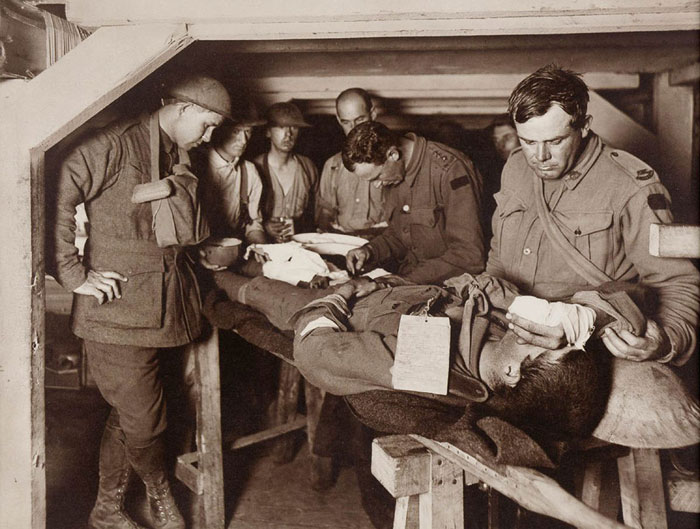
IMAGE: FRANK HURLEY/STATE LIBRARY OF NEW SOUTH WALES
“A few Huns captured by the Australians at Broodseinde.”
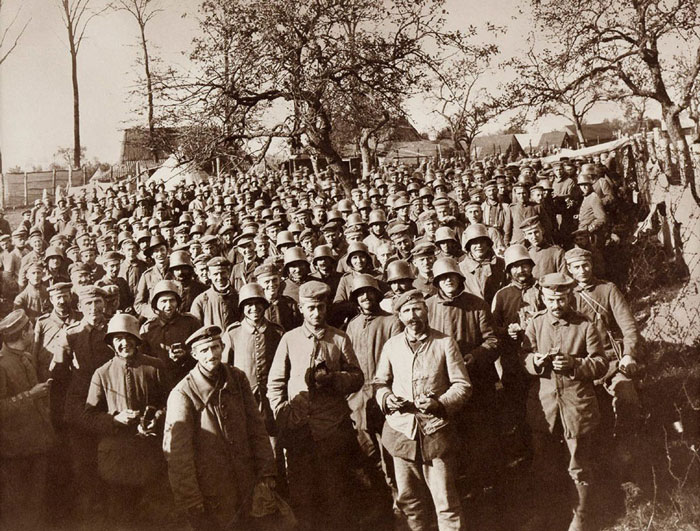
IMAGE: FRANK HURLEY/STATE LIBRARY OF NEW SOUTH WALES
“Sept. 20, 1917
A large number of prisoners were captured and sent in … in extremely poor condition, haggard, emaciated and dejected. Many were mere boys and shadows of men. One could not help feeling regret for these wretched prisoners, forced into the front line no doubt on account of their inferiority and intended merely as buffers: whilst the finer troops were held in reserve.
Germany is done and it is heinous cruel and pitiful that their and our own young lives should be wasted by the thousand, when their object can never be obtained. The sooner this hellish barbarism is ended God be praised for few can see what real good can be gained.
“Derelict tanks knocked out of action by an enemy tank strafing gun.”
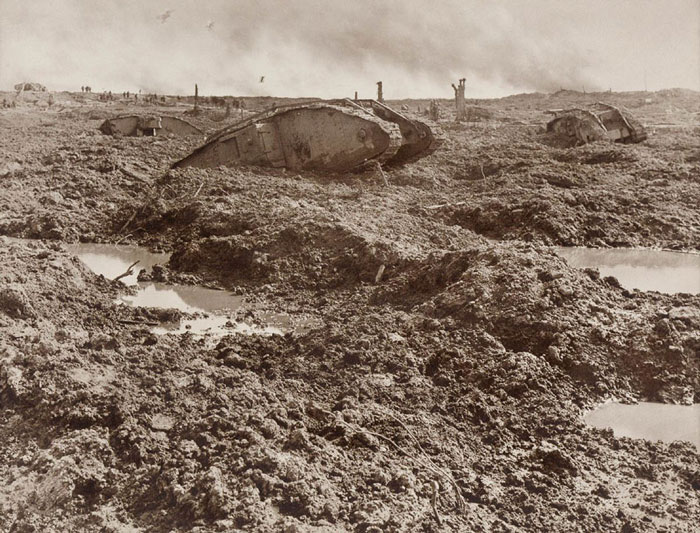
IMAGE: FRANK HURLEY/STATE LIBRARY OF NEW SOUTH WALES
“A windy outpost on Westhoek Ridge.”
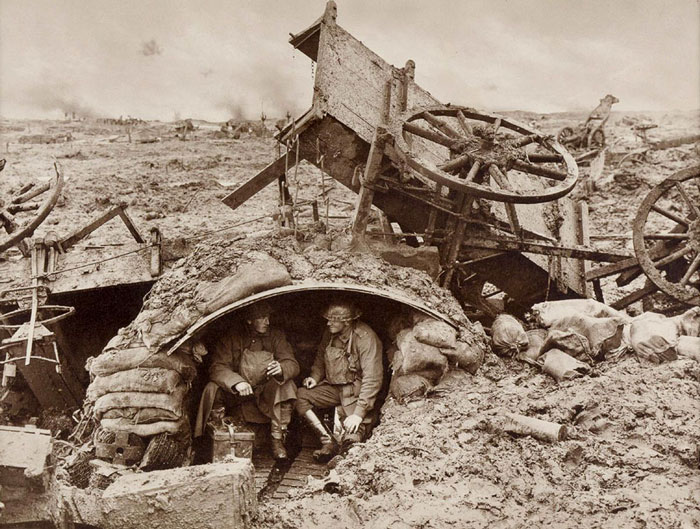
IMAGE: FRANK HURLEY/STATE LIBRARY OF NEW SOUTH WALES
“A Howitzer of the 55th Australian Siege Artillery in its lair.”
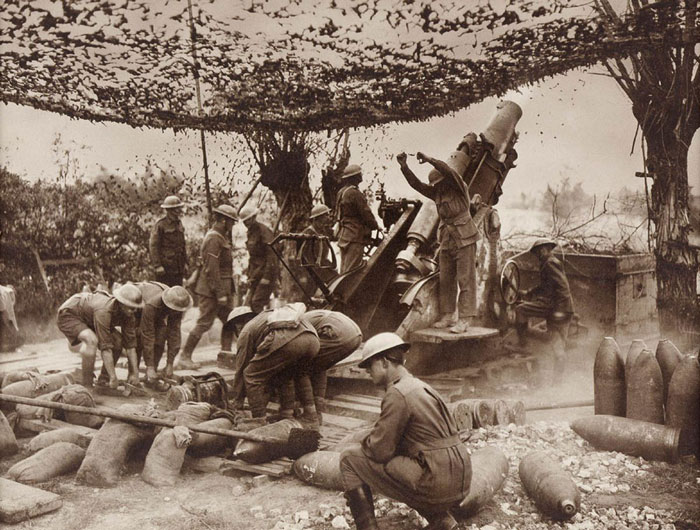
IMAGE: FRANK HURLEY/STATE LIBRARY OF NEW SOUTH WALES
“Hauling up an 18 pounder across captured ground to an advanced position.”
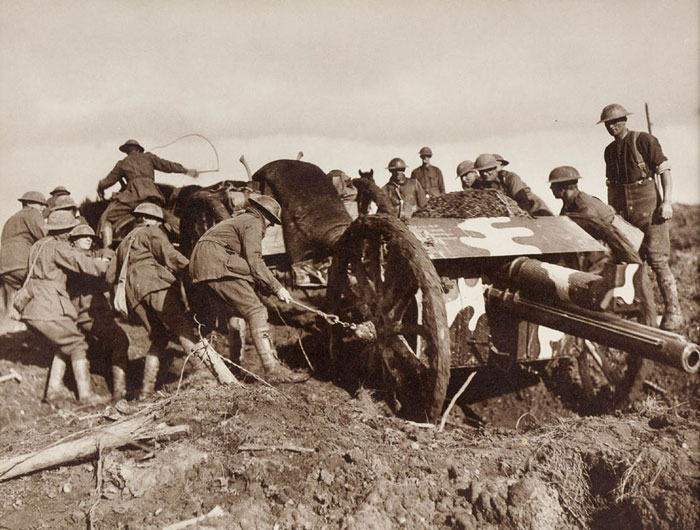
IMAGE: FRANK HURLEY/STATE LIBRARY OF NEW SOUTH WALES
“Sept. 28, 1917
I had the questionable excitement of being potted at by a sniper; the ping of his shot whizzing past only a few yards away. This did not deter me getting a fine series of pictures of how our chaps live in the trenches. I also came across a weird individual, whose sole mania is collecting souvenirs. He goes into all positions and dives with a whoop on new prisoners and “acquires” the proprietorship of all their unprisonerlike trinkets and possessions. I took a photograph of him surrounded by a heap of watches, chains and innumerable miscellanies.
“‘Wild Eye,’ The Souvenir King.”
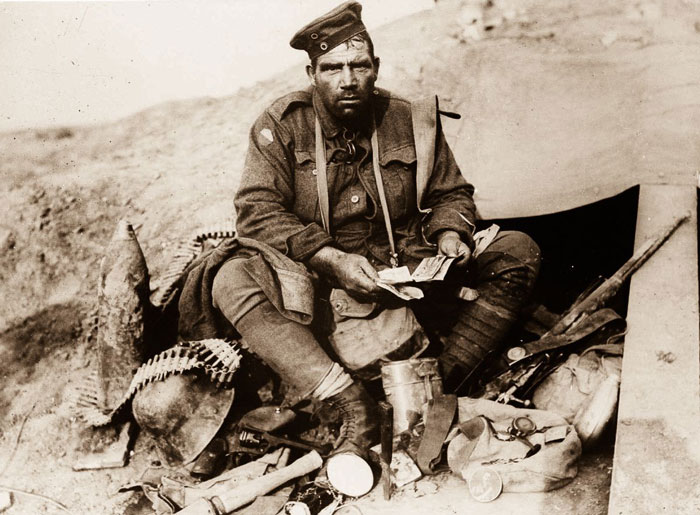
IMAGE: FRANK HURLEY/STATE LIBRARY OF NEW SOUTH WALES
“A tired battalion marching out of line.”
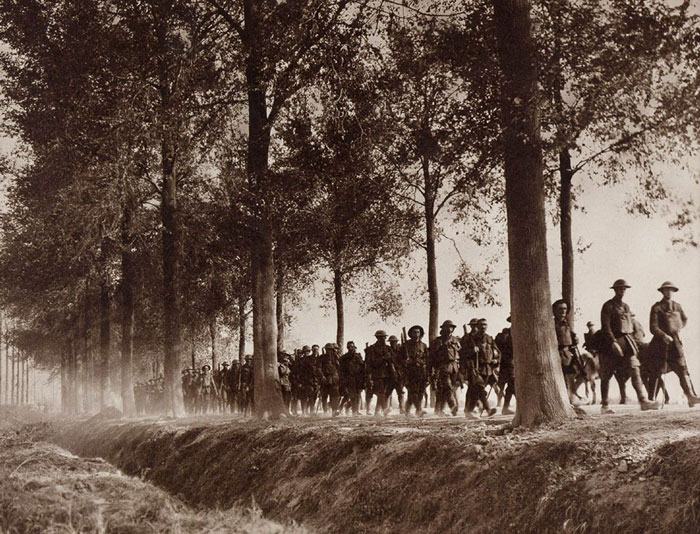
IMAGE: FRANK HURLEY/STATE LIBRARY OF NEW SOUTH WALES
“Carrying in the wounded during the height of battle.” (Multiple negative composite)
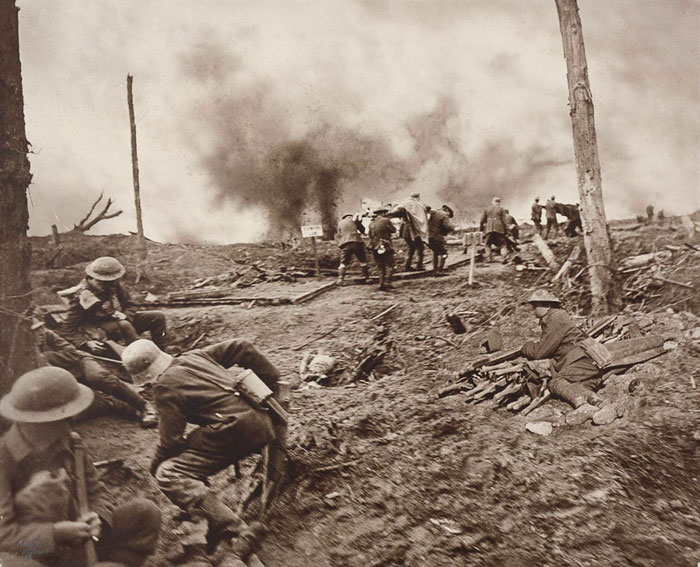
IMAGE: FRANK HURLEY/STATE LIBRARY OF NEW SOUTH WALES
“Hell-Fire Corner. Showing the difficulty of transport along an exposed highway.”
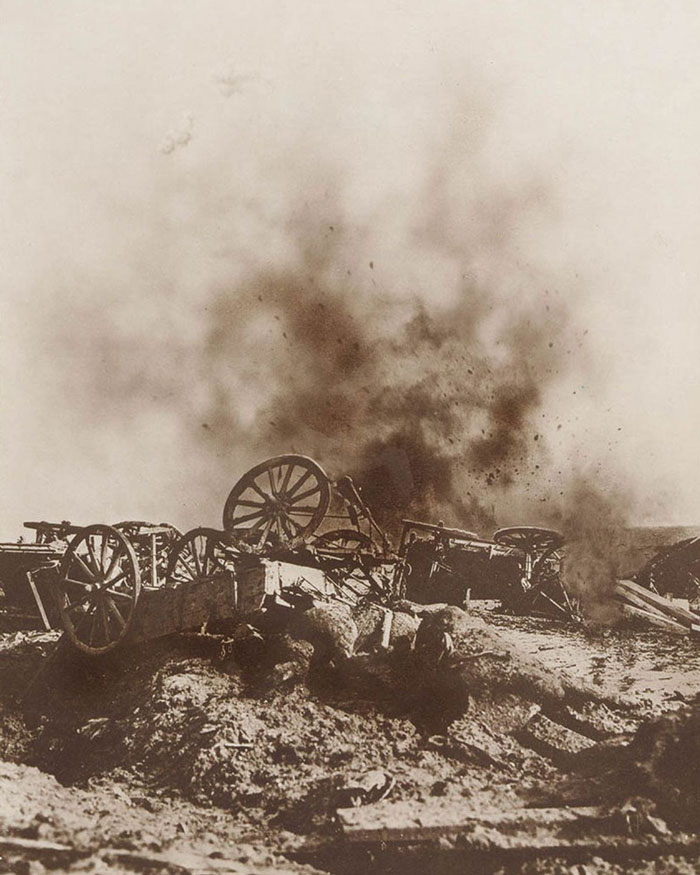
IMAGE: FRANK HURLEY/STATE LIBRARY OF NEW SOUTH WALES
“Sept. 26, 1917
In spite of heavy shelling by the Boche, we made an endeavour to secure a number of shell burst pictures. Many of the shells broke only a few score of paces away, so that we had to throw ourselves into shell holes to avoid splinters. I took two pictures by hiding in a dugout and then rushing out and snapping.
We have even a worse time than the infantry, for to get pictures one must go into the hottest and even then come out disappointed. To get war pictures of striking interest and sensation is like attempting the impossible.
Had a great argument with [Australian war historian Charles] Bean about combination pictures. Am thoroughly convinced that it is impossible to secure effects — without resorting to composite pictures.
“The dawn of Passchendale. The Relay Station near Zonnebeke Station.” (Multiple negative composite)
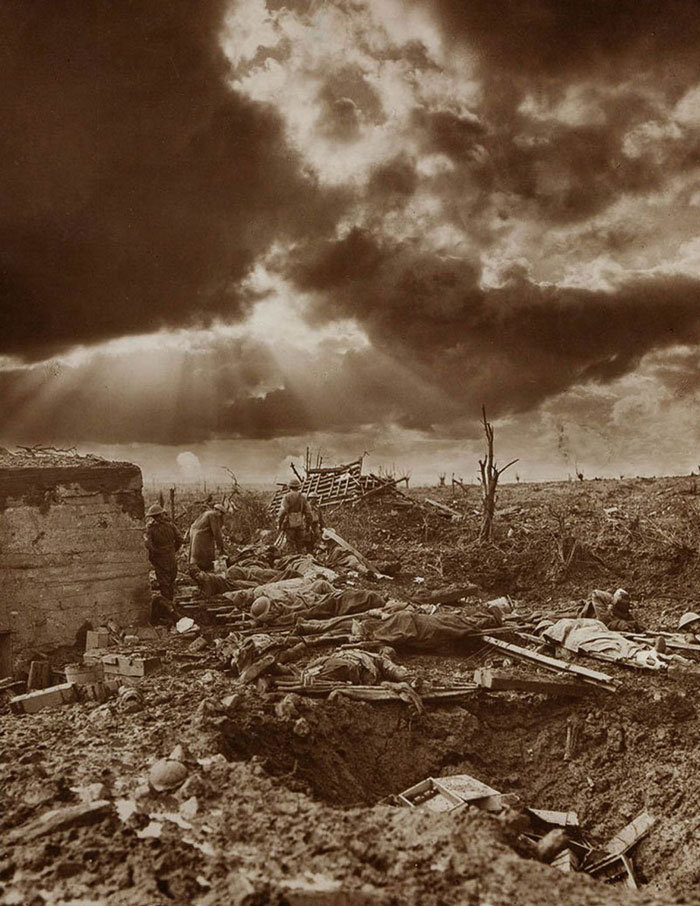
IMAGE: FRANK HURLEY/STATE LIBRARY OF NEW SOUTH WALES
“Oct. 1, 1917
Our Authorities here will not permit me to pose any pictures or indulge in any original means to secure them. They will not allow composite printing of any description, even though such be accurately titled nor will they permit clouds to be inserted in a picture. As this absolutely takes all possibilities of producing pictures from me, I have decided to tender my resignation at once. I conscientiously consider it but right to illustrate to the public the things our fellows do and how war is conducted. These can only be got by printing a result from a number of negatives or reenactment.
“Oct. 2, 1917
I sent in my resignation this morning and await the result of igniting the fuse. It is disheartening, after striving to secure the impossible and running all hazards to meet with little encouragement.
“Oct. 6, 1917
I am sending in 150 negatives this week. Headquarters have given me permission to make six combination enlargements in the exhibition! So I withdrew my resignation. They must at least appreciate my efforts, as they were dead against this being done. However, it will be no delusion on the public as they will be distinctly titled, setting forth the number of negatives used, etc…
“Battle scarred sentinels.” (Multiple negative composite)
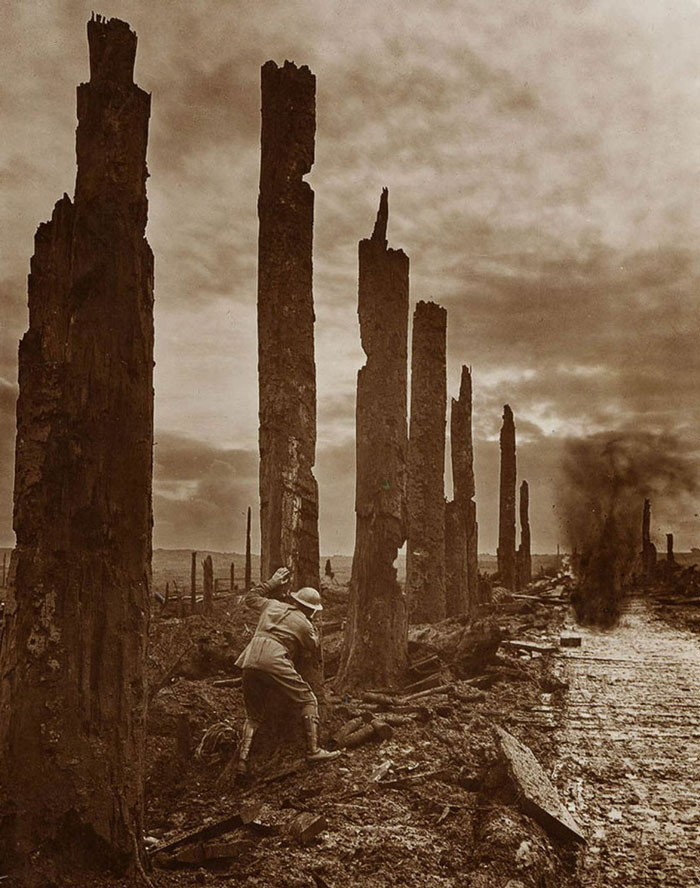
IMAGE: FRANK HURLEY/STATE LIBRARY OF NEW SOUTH WALES
“Looking out from the entrance of a captured Pill-Box on to the shell ravaged battlefield.” (Multiple negative composite)
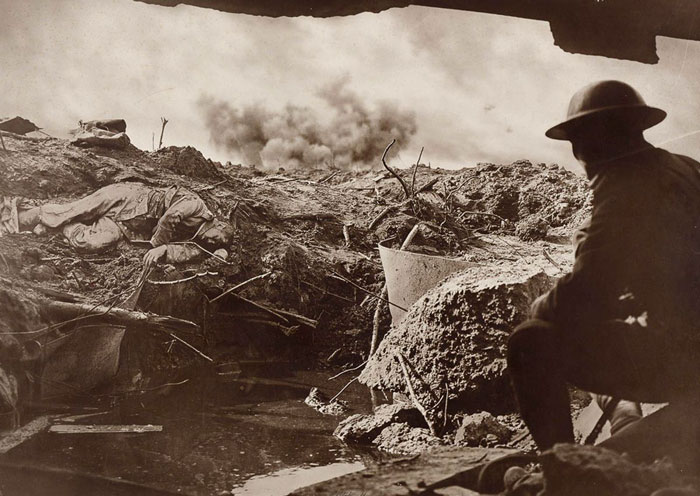
IMAGE: FRANK HURLEY/STATE LIBRARY OF NEW SOUTH WALES
“Oct. 26, 1917
Mud splashed in a continuous spurt from thousands of wheels whilst soaked and weary men heartily cursed the weather, the war and even their existence. It’s terrible that these poor soaked wretches have to go up into the front trenches this evening, and there be subject to the wretched weather and the hellish shelling. The misery of it all is too terrible and appalling for words.
“The World’s most infamous highway, the Menin road on a winter’s sunset.”
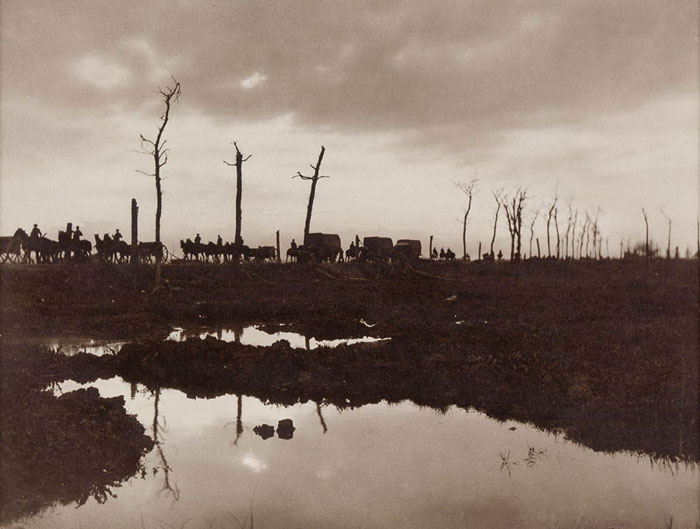
IMAGE: FRANK HURLEY/STATE LIBRARY OF NEW SOUTH WALES
“Aug. 23, 1917
Until my dying day I shall never forget this haunting glimpse down into the mine crater on Hill 60, and this is but one tragedy of similar thousands and we who are civilized have still to continue this hellish murder against the wreckers of humanity and Christianity.
Four miles of this or less have taken us three years to win! Around this small mound (Hill 60) on which we stood, hundreds, nay thousands of lives have been lost. What was it worth before the war? — just a pound or two; and after the war? Probably less.
“Infantry moving forward to take over the front line at evening.”
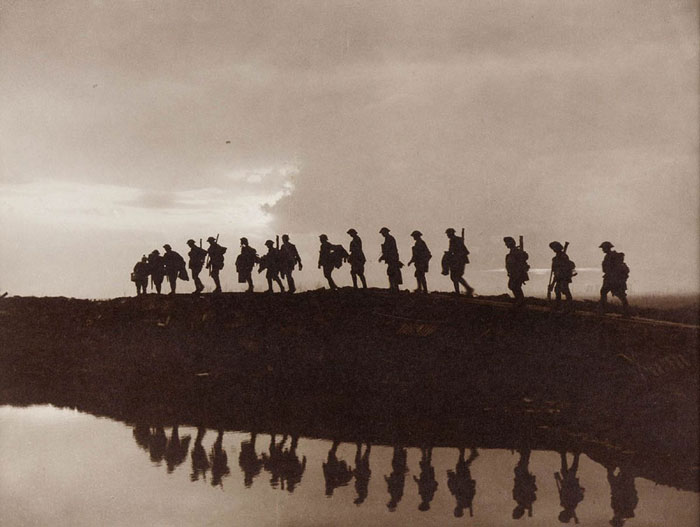
IMAGE: FRANK HURLEY/STATE LIBRARY OF NEW SOUTH WALES

